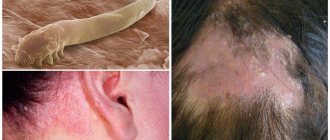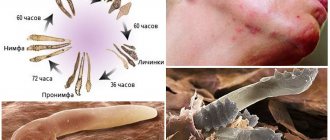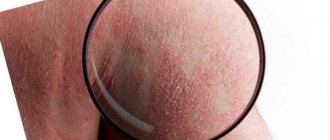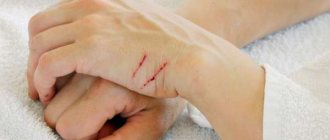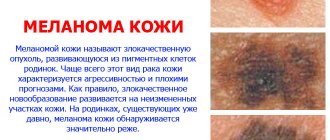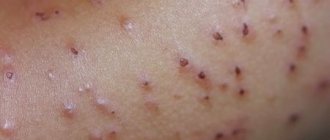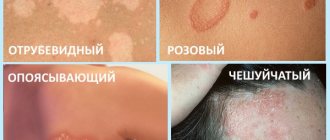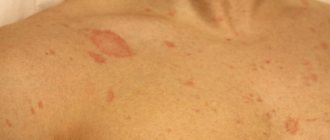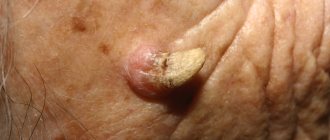Dermatology
3456
no comments
Seeing the world is a great happiness. The average healthy person takes vision for granted. Therefore, without regret, he spends his time to worsen his vision. Many hours at the computer, incorrect postures or sitting too close in front of the TV, over the years, make themselves felt by diopter violations. Such a threat is perceived as something distant, and therefore we will not talk about it. Vision problems also happen for other reasons. This could be a speck that has gotten into the eye, or a disease that affects the eyelid and eyelash areas. Pathologies appear for various reasons, but let’s consider one of the most dangerous and unpredictable – the reproduction of demodex mites. Demodicosis of the eyelids in humans (this is the medical definition of this pathology) causes a lot of suffering, is fraught with painful manifestations and symptoms, and requires urgent attention to a specialist.
A few words about the pathogen
The mite that causes demodicosis of the eyelids (in the photo you can see what this parasite looks like under a microscope) is very small. It can only be examined using special equipment. It grows in length from approximately 0.2 to 0.5 mm. It multiplies in hair follicles and sebaceous glands. Dead skin cells are food for these parasites.
It is worth noting that demodex mites are present in the body of every person. In certain quantities this is considered normal. It does not cause any pathologies, as it is an opportunistic pathogen. Intensive development of the parasite can provoke a decrease in immunity. Pathology also appears during chronic diseases.
In medicine, several forms of demodicosis are diagnosed: blepharoconjunctivitis, seborrhea, rosacea and blepharitis. It is important to understand that when the first symptoms are detected, it is necessary to begin treatment without delay. The fact is that demodex waste products can provoke severe allergies.
Causes of demodicosis
The cause of demodicosis of the eyelids is infection with Demodex folliculorum mites, which parasitize hair follicles, sebaceous glands and ducts that extend to the surface of the skin.
Dermatologists say that these types of mites parasitize almost 100% of people. Thus, mites are representatives of the skin microflora. Their number changes with age. Infection with demodicosis of the eyelids occurs in two ways:
- directly from a person who is a carrier of the disease;
- through bed linen or underwear used by the patient.
There are several known external factors that contribute to the development of the disease, among the most common are the following:
- previous ophthalmological surgery;
- frequent stay in a room or area with polluted air that contains a large number of dust particles;
- long-term residence in an area with high atmospheric temperature and high humidity;
- abuse of bad habits and frequent consumption of alcoholic beverages.
In addition, experts also identify physiological reasons that lead to the development of demodicosis of the eyelids, for example:
- CNS diseases;
- reduced immunity caused by frequent viral diseases;
- hormonal imbalance;
- diagnosing diabetes mellitus;
- dysfunction of the liver or gastrointestinal tract;
- failure of the exchange system.
The impact on the human body of one or more reasons creates favorable conditions for female mites at the mouth of the follicle to begin laying diamond-shaped eggs. A large number of eggs leads to the appearance of the first signs of the disease.
What causes the pathology?
Demodectic mange of the eyelids in humans occurs when the opportunistic form of the mite transforms into a pathogenic one. This can be caused by diabetes mellitus, hormonal disorders, and various gastrointestinal diseases. Adolescents during puberty are also at risk.
The environmental climate causes abnormal activity of ticks. Their reproduction is facilitated by high air temperatures and humidity levels. It is better for the patient to refuse to visit the bathhouse or sauna, as this will contribute to the rapid development of the pathology. During the summer season, it is recommended not to stay in hot rooms for a long time.
How is the disease transmitted?
Demodicosis of the eyelids is a contagious disease, so it is recommended to isolate the patient. Currently, medicine knows many sources that can cause the development of pathology. These include:
- Poor quality treatment of bed linen. The risk of infection increases for people who frequently travel by train or stay in hotels.
- Cosmetics for an already sick person. There may be a parasite on the brush used to apply mascara to the eyelashes. Pencils and eye shadows are also a source.
- Personal hygiene tools. In most cases, infection occurs in salons where disinfection is carried out incorrectly.
- People with this disease. Infection occurs through contact with them.
- Infected pets.
Prevention
In the treatment of demodicosis, it is important to understand that the disease is contagious. In order to avoid infecting others, it is necessary to strictly adhere to the rules of personal hygiene.
There are recommendations that, if followed, will help you recover from demodicosis faster and avoid possible infection of other people:
- It is better to wipe your face after washing not with a terry towel, but with a paper one.
- Daily change of pillowcase is required. After washing, it must be treated with a hot iron.
- To treat personal belongings, you should use alcohol, ether, an alcoholic solution of salicylic acid, or boiling water.
- All cosmetics that are likely to be infected with mites should be discarded.
- The eyes should take a break from makeup during treatment.
- It is better to replace down and feather products with synthetic ones.
- It is important to take all measures to improve immunity.
Demodicosis of the eyelids: symptoms
In most cases, the first symptom of demodicosis is inflammation of the skin of the eyelid. In some cases, the pathological process begins to grow, involving the eyeball. If the lesion is concentrated specifically on it, then doctors will diagnose blepharoconjunctivitis.
The patient should pay attention to the fact that the exacerbation of the disease is seasonal. In most cases, it is activated in the summer or spring seasons.
Other symptoms may also appear. Demodicosis of the eyelids (treatment will be discussed a little later) is characterized by severe itching. Its intensity increases if cream or other cosmetics are applied to the affected area. Some of them contribute to the development of mites. In addition to itching, the skin on the eyelid turns red and swelling appears. With this disease, eyelashes may fall out, barley, peeling and even purulent crusts may appear. Often the patient may feel a strong burning sensation. When the eyeball is affected, photophobia and increased lacrimation also develop.
Another symptom is discharge from the eye in the form of a yellow liquid. After some time, pustules begin to form around the eyelid. They are small blisters containing a capsule of pus inside. When it bursts, crusts form on the eyelashes. This is especially noticeable in the morning, as patients talk about in their reviews. Demodicosis of the eyelids requires immediate treatment. The fact is that the waste products of the parasite can cause allergies. And if in one person it manifests itself only as a rash, in others it can cause serious complications.
It is important to closely monitor your health and see a doctor at the first symptoms. Why is it not recommended to tighten? The fact is that demodicosis of the eyelids in humans can become chronic. Treatment started in a timely manner will avoid unpleasant consequences. In its chronic form, the disease manifests itself as depression, nervous disorders, weakness, and decreased activity. In some cases, a person falls into long-term depression.
Clinical picture and pathogenesis
Eyelash mites provoke the development of not only cosmetic ailments, but also nervous system disorders. Many patients, upon hearing the doctor’s diagnosis of demodicosis, panic. It seems to them that they tactilely feel how the pest moves under the skin.
The disease is accompanied by loss of eyelashes, and new hairs grow incorrectly or even grow into the epidermis. In most cases, the disease causes inflammatory processes that develop along the edge of the eyelid. The anomaly also causes the following harm to the body:
- The appearance of cylindrical dandruff near the eyelashes;
- The functioning of the meibomian glands is disrupted, they swell, which leads to the formation of cysts;
- The amount of fat-soluble vitamins in the tear fluid decreases;
- If streptococci enter the body, blepharitis develops;
- Since the visual apparatus perceives the tick and skeleton as a foreign body, an inflammatory reaction with the formation of nodules is possible;
- The pest contains bacteria inside, so when it enters the body, it begins to actively produce bacterial antigens. The result of all these processes is inflammation;
- The risk of stye or epithelial injury, which can develop into a corneal ulcer, cannot be excluded.
| Eyelash mites belong to the category of opportunistic microorganisms. Therefore, all the negative signs that appear after it settles in your body arise not because of demodex itself, but as a result of its active activity. |
Return to contents
Diagnostics
Only an ophthalmologist can make a diagnosis. In order to determine demodicosis of the eyelids, as a rule, a simple examination is sufficient. The specialist pays attention to the symptoms, which are expressed by the formation of crusts, redness and swelling of the eye. In most cases, additional examination is not necessary. Diagnosis of this disease is quite simple.
In order to identify the pathogen, the doctor uses a microscope. Thanks to the high magnification, a small tick will be clearly visible. How is the parasite detected?
- The material used is the eyelashes of a sick person. They are taken from both eyelids.
- Place them on a glass slide.
- Using a glycerin composition with the addition of water, the eyelashes are fixed.
- After this, they are covered with glass and placed under a magnifying glass of a microscope.
- The study is carried out in transmitted light.
After the laboratory technician has determined the number of ticks (deviation from the norm - two or more individuals), the diagnosis is confirmed. Based on this information, the doctor selects treatment for demodicosis of the eyelids.
Diagnostics does not take much time. In most clinics, it is performed immediately, so the patient will know the result at the first appointment.
Diagnostic methods
Usually there are no problems identifying the disease. In some cases, it is enough for the ophthalmologist to conduct a visual examination of the patient to detect swelling and redness of the eyelids, pustules and yellow crusts around the eyelashes.
To confirm a preliminary diagnosis, the doctor conducts an examination using a microscope:
- For analysis, several cilia are taken from each eye from the patient;
- They are placed on a glass slide;
- Using a special composition based on glycerin and water, the hairs are fixed;
- A cover glass is placed on top;
- The material is examined under transmitted light.
If the pest is found in quantities of more than two, then the preliminary diagnosis is confirmed and optimal therapy is selected. The procedure takes only a few minutes and is usually performed in front of the patient.
Treatment
While this disease is easy to diagnose, it is much more difficult to treat. Sometimes the struggle can drag on for several months. To achieve a full recovery, it is important to strictly follow your doctor's recommendations. If anyone thinks that they can take one pill and everything will go away, then they are greatly mistaken. This disease can only be overcome with complex therapeutic methods.
So, how to treat demodicosis of the eyelids? First of all, you need to stop the infection. At the same time, the doctor prescribes medications that will help improve metabolism, strengthen the immune system and eliminate the consequences caused by hormonal disorders. Also during treatment, agents are used that relieve the inflammatory process in the skin of the eyelids.
As a rule, eye drops, special creams and ointments are prescribed to combat demodicosis. In addition, it is important to follow diet and personal hygiene rules. During therapy, all actions should be aimed at eliminating the underlying pathology, that is, neutralizing the action of the mite.
In order to strengthen the body, you will need to take immunomodulatory drugs. They will be effective if the treatment is supplemented with vitamin complexes. Also, the doctor must prescribe special medications that improve the functioning of the gastrointestinal tract. At the beginning of treatment, you will have to take a course of anthelmintic and antiallergic drugs.
Medications
Let's look at the medications used to treat demodicosis of the eyelids in humans. For these purposes, drugs such as Demalan and Blefarogel are most often used. Metronidazole gel is also quite effective. For procedures, a one or two percent composition is used.
Most doctors prefer Blefarogel. A positive result is achieved due to the fact that this drug contains sulfur. In addition to its main action (eliminating mites), it cleanses the ducts of the sebaceous glands. Hyaluronic acid, which is also found in Blefarogel, accelerates skin regeneration, promotes healing and strengthens the immune system.
Complex therapy includes taking antihistamines. Of all those available, it is worth highlighting “Lecrolin” and “Diazolin”. For preventive purposes, medications that prevent the development of bacteria are excellent. This group includes Tetracycline, Albucid, Okomistin and others.
Ointments
Demodicosis of the eyelids is a disease for which doctors often prescribe ointments for treatment. It is not recommended to select them yourself; it is better to consult a specialist. For reference, some drugs used to treat pathology will be presented below. Reviews say that they are the most effective.
- Sulfuric ointment. This type of mite responds well to medications that contain sulfur. Thanks to the balanced composition of this ointment, it is possible not only to destroy parasites, but also to accelerate skin regeneration, as well as disinfect damaged areas. Such an effective drug is inexpensive, which is why it is popular among people. On average, the course of treatment lasts about 12 days. But before using this ointment, patients should be aware of two significant disadvantages. Reviews say that it has a rather specific smell, which is unpleasant to many, and also leaves greasy stains on things and bedding.
- Ichthyol ointment. Most people are very familiar with this drug. It is used to relieve inflammation, fights purulent discharge and relieves pain. In order for the treatment to be effective, the ointment is applied to the eyelids three times a day.
- To treat demodicosis of the eyelids, you can use Yam ointment. It is a dermatological product. Effectively acts on fungal bacteria and mites. The course of treatment is 14 days. Apply to the eyelids twice a day, for example, morning and evening. However, this must be done correctly, so using the drug on your own is not recommended. You should definitely consult your doctor.
- Permethrin ointment. This drug has a local effect. It is an acaricidal and insecticidal agent. The active substances that make up the ointment are able to act on the tick from the inside, that is, they enter its body and first paralyze it, and then completely destroy it. The skin of the eyelids is treated three times a day. Important! The ointment should not get on the eyelashes. The maximum duration of the course is 14 days, after which you must make an appointment with your doctor again.
Treatment of demodicosis of the eyelids and face using folk methods in humans
Folk remedies for the treatment of demodectic blepharitis can only be used in combination with medications.
Do not self-medicate or ignore doctor's orders under any circumstances.
Anabasis for demodicosis
Anabasis is a shrub that grows in the floodplains of the Volga and Don, as well as in the Crimea. It contains a special alkaloid – anabasine, which is famous for its antifungal and antiparasitic effect.
Anabasine penetrates well into tissues and kills all pathogens, including ticks. It is used for local treatment in the form of an alcohol infusion, which is used to treat the eyelids twice a day.
Sagebrush
Take 2 tbsp. dry wormwood herb, add a liter of water and place on low heat. Boil for a couple of minutes and leave to brew for 2-3 days. Take orally according to the following regimen:
- Day 1: 50 ml every hour;
- Day 2: 50 ml every couple of hours;
- 3rd and subsequent days: at the same dosage every three hours.
A decoction of wormwood not only helps get rid of demodicosis, but also normalizes the functioning of the intestines and stomach.
Black currant
Take 4 tbsp. dried berries, pour 0.5 liters of boiled water and boil for 7-10 minutes. When the broth has cooled, use it as a lotion 2-3 times a day.
Lotions made from decoctions of chamomile, oak bark and calendula also have a good effect.
Drops
Treatment of demodicosis of the eyelids (see below for a photo demonstrating the process of such therapy) necessarily includes the use of special drops. However, unlike conventional eye medications, they are not instilled orally, but are simply applied to the outer part of the eyelid. They are quite effective, since these are the places where ticks are located. In order to treat the skin with drops, you will need to apply a small part of the liquid to your fingertips, and then simply massage your eyelids. A cotton swab is also suitable for these purposes. They are instilled directly into the eye only if the patient experiences unbearable itching or burning. These symptoms indicate an inflammatory process.
Currently, pharmacies offer a large assortment of such drops. In the comments, people speak well of Phosphacol and Carbachol. These drugs are acaricidal. Can only be used on the outer parts of the eyelid. You can't roll them into your eyes.
If the disease is complicated by infection, doctors prescribe antibacterial drops. They help to quickly relieve the inflammatory process, which will make a person’s life much easier. Most people have positive reviews about chloramphenicol drops, “Ciprofloxacin”. You can reduce the symptoms, which manifest as severe itching, by using Dexamethasone, Okumetil and other similar medications. It is important to remember that they can only be taken after consulting an ophthalmologist.
Preparations for the treatment of demodicosis
To treat demodicosis of the eyelids, ophthalmologists recommend using a number of medications, including drops, ointments and gels:
- Licontin Comfort Neo.
Drops are a solution that has a moisturizing effect. They prevent dryness of the eye mucosa as a result of the formation of a thin hydrophilic film. In addition, the product has disinfectant properties. - Hilo chest of drawers.
The use of drops helps to quickly and effectively relieve dryness and irritation of the eye mucosa. With their help, it is possible to relieve eye fatigue. - Artelak Balance.
Regular use of the solution provides relief from such unpleasant symptoms of demodicosis of the eyelids as dry mucous membranes, the feeling of a foreign object in the eye, fatigue, redness and inflammation of the eyes. - Systane.
An ophthalmic solution, the use of which helps to get rid of dryness, irritation and fatigue of the cornea of the eye caused by external factors and the development of demodicosis of the eyelids. - Sulfuric ointment.
The product has an antiseptic effect. Helps remove the inflammatory process of hair follicles and the skin of the eyelid contour. It is recommended to apply a thin layer to the skin and eyelashes. - Permethrin ointment.
Prescribed by ophthalmologists for the treatment of demodicosis of the eyelids. Helps reduce inflammation of the skin around the eyelids. The course of treatment with ointment lasts from 2 to 3 months. - Zinc.
The ointment has an anti-inflammatory and antibacterial effect. Showed itself well in the treatment of demodicosis of the eyelids. It is not recommended to use if you are allergic to the components of the product. - Ointment Rosamet.
The active ingredient of the drug is the antibiotic metronidazole, which helps destroy bacteria secreted by subcutaneous mites during their life. - Benzyl benzoate.
It has an antimicrobial effect in the treatment of illness. The ointment should be used only as prescribed by a doctor, due to its toxicity. - Stop Demodex.
The gel can be used both for the treatment and prevention of demodicosis of the eyelids. It has antiseptic, antiprotozoal and antibacterial properties. Apply with a cotton swab to the roots of the eyelashes. After 30-40 minutes, the remaining gel is washed off with warm water. - Blefarogel.
The product helps to easily remove crusts and remnants of purulent discharge from eyelashes and the edges of the eyelid. Reduces the skin's ability to secrete sebum.
Folk remedies will help increase the effect of therapeutic therapy through the use of medications. For example, warm compresses from herbs such as chamomile, calendula, aloe juice, tansy oak bark.
To prepare the decoction, take 1 tbsp. spoon of dry herb and pour a glass of hot water over it. The decoction should steep for 20-30 minutes. After this, it should be strained. Moisten a swab or gauze pad with warm broth and place it on your eyes. After 15-20 minutes, the compress can be removed.
The use of such compresses helps cleanse the eyelids and eyelashes of dried purulent secretions, ensures disinfection of the skin, and prevents the development of the inflammatory process.
It should be noted that before using such compresses, you should first consult with your doctor.
The use of these and other drugs is carried out in combination as prescribed by the doctor for each patient individually.
Hygiene
An integral part of the treatment of demodicosis is hygiene. Even if you take all the medications prescribed by your doctor, you will not be cured without special procedures. As mentioned above, with this disease crusts form on the eyelashes. Also, many people have flaky skin. It is important to regularly cleanse the affected areas of these formations. Without such a procedure, the effectiveness of all medications will be zero.
Experts recommend cleaning your face and eyelids daily with tar soap. As a rule, it can be purchased at any pharmacy. If for some reason this soap is not suitable, for example, you have very dry skin, then you can replace it with calendula tincture. It is great for cleansing procedures. People with sensitive skin are encouraged to try a good product. It's called "Blepharolosion". It contains chamomile, which has an anti-inflammatory effect, green tea, hemodez. The last component removes toxic substances from the body, thereby cleansing it and strengthening the immune system.
Demodectic mange of the eyelids: reviews from women
In conclusion, let's talk about what worries women most. In their reviews, they often talk about cosmetic products and the likelihood of infection. Yes, indeed, this disease can be transmitted. Therefore, it is important to visit only trusted beauty salons. You should not use other people's cosmetics. And if the first symptoms appear, you will need to completely abandon makeup. Be sure to visit a doctor and start treatment. But it’s better to throw away old cosmetics in order to prevent secondary infection.
Prevention of demodicosis in humans
Prevention of infection is possible provided that exposure to provoking factors leading to infection is excluded, as well as a decrease in immune activity.
In order to cure the disease forever, an integrated approach is important, eliminating further exposure to provoking factors. More detailed information about how to treat diseases of the eyelids and eyelashes, whether parasitosis is contagious or not, as well as how to avoid it, can be obtained at an appointment with an ophthalmologist.
Author of the article: Igor Mikhailovich Krivoguz, specialist for the website glazalik.ru Share your experience and opinion in the comments.
